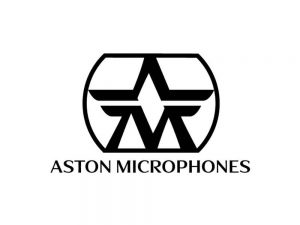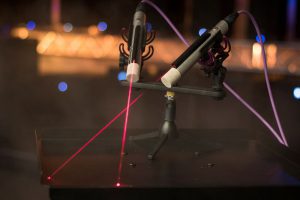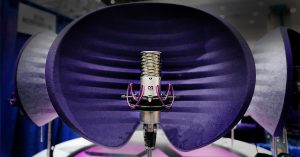
The world wasn’t really expecting, wanting or needing yet another microphone, let alone another microphone brand, to appear in 2016.
Most would’ve said, “Okay, there’re enough kids in the pool at this point. Let’s stop the propagation before one of ’em breaks the ‘no pee‘ rule!”
But despite our jaded-gearhound cynicism, a resounding SPLASH was heard ’round the pro audio pool last year, the waves of which are still gently bobbing us towards superlative sound here in 2017.
The debut line of Aston microphones has arrived, people, and quality sound is more attainable than ever!
We Love Critics! Let’s Go Find a Bunch!!

It’s not every day that a product is made by a group of USERS, instead of just profit shakers and specs-focused engineers. Aston decided before they opened that they would demand of themselves as a microphone company the highest audio outcomes for their products.
The biggest way they chose to do that and keep themselves accountable to their goal is by bringing together a “Development Panel” of pro audio experts who work daily in the field as their ears for testing. The sheer breadth of knowledge and number of collaborators in this panel is daunting; I’ve never seen so many amassed to bring their competence to bear upon a singular product. Here’s the full list of panel auditors: http://www.astonmics.com/the-a…
But they didn’t just ask these folks to use the mics and then help ’em endorse them: they conducted double-blind listening tests to prove that these mics could stand up against the big boys. Finally, after months of tweaking, Aston chose to deliver the mics that consistently impressed their pro audio consultants to the point where they all wanted one of their own. Now that’s what I call a job well done.
Obviously these guys and gals are into the details. Their focus is on making products that audio professionals can use, day in, day out, and actually want to use. No small feat considering the dizzying array of mics that are available in this day and age. I first was told about these mics by a fellow musician and G.A.S.-er who said was using one over a Neumann (more on that to come). That got my attention pretty quick. And so, dear readers, this is why we’re here. Let’s take a peek into the products of this rare ensemble of audio nerds…
The Starlight: A G.A.S.-y Wish Come True!
Okay, I’m just going to put this out there: putting a pointing laser on a pencil mic?? Brilliant move!

Not only is that extremely usable feature that I would use every time for drum overheads, but, can we just talk about the cool factor a minute? What client is not going to mention something about those lasers being the bomb when they see the engineers setting the mics up and using ’em? They’re like mini Star Wars light sabers making that “Hhruoom” sound over the drum kit! You know the one. “Hhruoom.Hhruooooom!!”
Help me, Aston Kenobi, you’re my only hope for an engineer that knows what they’re doing.
Your clients will also know by the mock laser battles that you, along with your closet of classic ‘older mics’, are staying on the cutting edge of things for their recordings, with new, fancy-schmancy gizmos, and since they’re our bread and butter, that’s what matters.
For the Starlight mic, Aston expanded their Development Panel from 33 to 50. They knew this mic would be used on many different sound sources, so they opted for more diversity in the auditing – a brave and vulnerable move on their part. But this is what separates the Poe’s from the posers, folks…and it worked.
In testing this mic actually caused a ‘listeners rift’ between our friendly auditing panel. Aston discovered as they put the starlight through its paces that half the pro audio guys liked the “old school sound” of small diaphragm condenser mics: those that exhibited a warm, “vintage” tone. The other half had a penchant for brighter, ‘airy-er’ sounding mics for their small condenser uses. With a pretty dead-even split, they did what any great compromiser does – they gave us both! What this means for the industry is we now have the first small diaphragm condenser mic that offers voicing options built in. Touché, Aston!
If you want specs and pics, check ’em out here. My personal take? Get two of these before the price is raised. They’re currently at $349 retail. But I can’t see the prices staying as low as they are now on any of these three mics. They’re that good. Oh, and the guy that sold me these (you rock, David at G.C. Southfield!!) thinks so too.
The Origin of Bees-Knees

Now we’re in the land of large condensers. It’s getting bigger in here! The Origin is designed to excel on acoustic guitars and vocals according to Aston and its secret weapon is the 1″ gold evaporated capsule that captures your sound source.
Aston went through hundreds of these types of capsules before they settled on three that were consistently awesome enough to put their name on.
There’s a gentle slope boost from about 3 to 20k on this mic, giving it some nice “air”, a definite must for acoustic guitars and vocals. Otherwise, it’s pretty flat from around 100 and up. I’m used to seeing mic frequency charts look pretty wavy and hilly. Not this contender! And with the rave reviews I’m hearing and reading it seems pretty clear: if you make something well you won’t have to EQ it up the wazoo.
Quiet. Smooth. Direct. I’d put it in the category of WYSIWYG. Not a whole lot of colorization going on here. It just transparently bears your soul clean, so… make sure you’re ready for a vocal session with this puppy. There’s no hiding! It will find you!!
Currently under $300 retail, if you’re just getting into audio, don’t have much cash but want a quality mic, especially for vocals, this has to be your first choice. For the price, I don’t see anything beating it out right now. Compare its specs here and you’ll see what I mean.
And the Spirit of the Waters Doth Call Thee…
The Spirit mic is the Aston option that I immediately was most interested in, because one of my engineer comrades told me he tried it out and since then is consistently using this mic instead of his Neumann U-87.
Impossible, you say?? Pas de tout, mon ami!
I myself had a similar experience, not choosing the esteemed U-87, years ago while testing mics for my first album. Check out that story here. But that just goes to show what a shocker this mic is with regard to quality per price point.

The Spirit is Aston’s better choice for acoustic guitar and/or vocals, as compared to the Origin, due to its lower noise floor.
If you’re doing a stripped-down number that needs a reeeeeally quiet mic, you’ve found it. Not to mention it’s extremely flattering EQ, which has only two slight hills at 4K and around 10K and is otherwise flat above 90 Hz.
It’s also tremendous that, at this price, we also get three polar patterns that all sound so good! If you need cardioid, omni or a figure-of-eight pattern, just dial it up on the mic and voilà… you’re in the zone.
I am more than happy about purchasing this mic. If you want to hear the recordings I made with it, showcasing the acoustic guitar and vocals, check out my SPIRIT MIC REVIEW HERE. Suffice it to say for now that I really think that, like me, you’ll appreciate what this baby brings to the studio, no matter what you want to use it for.
It’s hard to believe this mic is selling at a $449 retail price. These specs bespeak of a much more expensive microphone. When it first came out in 2016 it retailed for $299 (told ya it’s gonna go up!) but the sound it provides, trust me, is worth way more than either of those numbers.
Like I mentioned, it’s being compared to Neumann mics frequently. That says it all.
They Pooled Their Talent, Now Pool YOURS!

Aston pulls no punches. Because of the lengthy development, testing and auditing by pro audio purists of their microphones, they boldly state that these are the best-sounding mics available, not only at their price point, but well beyond it.
I, for one, think they’re onto something. The only area where I see these mics having any lack at all is in their self-noise numbers: they each rank in the “good” range at 15, 18, and 14 respectively. But the fact is that few condensers go below 10 dB. The Neumann TLM103 is one of them, but that mic retails for over $1,000!!

Unless you’re doing an extremely quiet song with, say, only a vocal and one soft instrument, you’re not even going to notice any noise at all. I didn’t, and my hearing is still very good thanks to vigilance against extreme sound levels. Just ask my son; he’ll tell ya: “Dad’s always saying to watch dB levels and wear earplugs if needed!!”

So, having dipped my foot into Aston’s private mic party pool for my own recordings, I heartily endorse their findings – these things really are as versatile and useful as they say they are. And I’ll go out on a very strong limb and say that I choose the Spirit as the best new, mid-priced condenser mic of the year for vocals. I’m lovin’ mine!!
Stay tuned for specific recordings from each mic. I’ll be A-B-ing them against other mics in my arsenal and will share the results, with you, soon.
Until then, definitely check these out. Make some music with them and let me know your results. These windows through which our talent shines can be murky or heavenly, but Aston is consistently making the angels sing.
Whether you have two or eighty-two mics in your closet, their products are almost a steal at current pricing, and will hold their own long into your production future.
For SeriousGAS.com, this is Teaj, sayin’…
… go… make… sounds!
